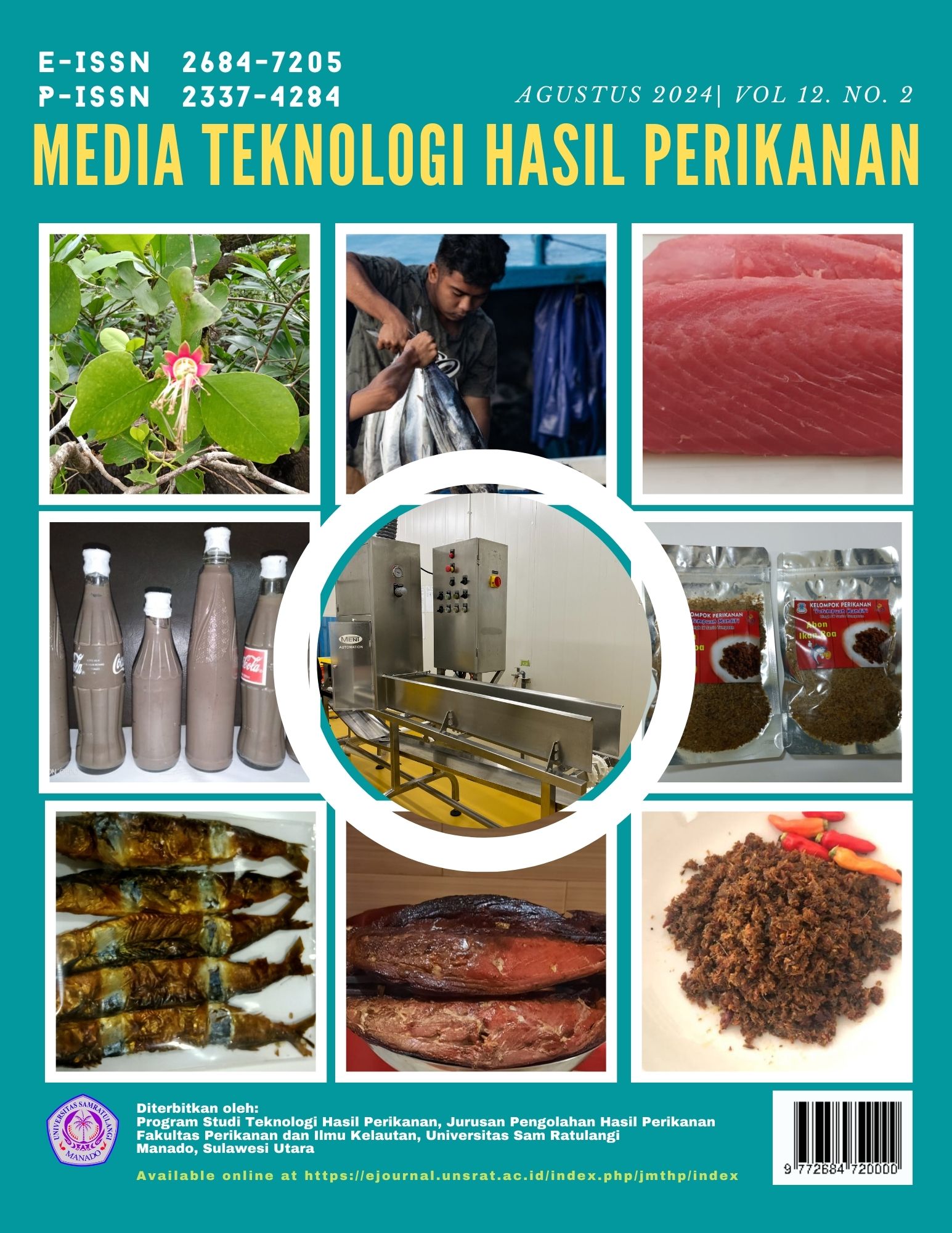MUTU STICK IKAN BELUT (Monopterus albus) DENGAN PENAMBAHAN TEPUNG KARAGENAN
The Quality of Eel (Monopterus albus) Fish Stick with Addition of Carrageenan Flour
DOI:
https://doi.org/10.35800/mthp.12.2.2024.52241Abstract
Indonesia is endowed with a plethora of diverse animal food sources, one of which is the eel fish (Monopterus albus). Eel is a fish that can be consumed as a functional food, exhibiting a higher nutritional content than ordinary foodstuffs and providing health benefits for the body. Eel is processed into a variety of products, including the eel fish sticks. It is anticipated that the production of eel fish sticks with the incorporation of carrageenan flour will enhance the cohesiveness and binding power of the product, thereby extending its shelf life. The objective of this study was to assess the quality of eel fish sticks (Monopterus albus) with the incorporation of carrageenan flour through organoleptic evaluations, fat content analyses, crude fiber assessments, and water content examinations. The results of the study indicated that the panelists preferred the 0% carrageenan flour treatment in terms of organoleptic characteristics, including taste, color, texture, and aroma, when compared to treatments with 5%, 10%, and 15% carrageenan flour. The water content value was found to be lower with the addition of 5% carrageenan (6.78) compared to the addition of 0% carrageenan (7.52). The fat content value with a 5% carrageenan addition (9.71) was found to be lower than that observed with a 0% carrageenan addition (11.03). The crude fiber content exhibited a higher value with the addition of 5% carrageenan (0.78) compared to the 0% carrageenan addition (0.48). Similarly, the dietary fiber content demonstrated a higher value with the addition of 5% carrageenan (0.60) compared to the 0% carrageenan addition (0.44).
Kata kunci: Carageenan, Eel, Monopterus albus, Stick
Indonesia memiliki kekayaan sumber pakan hewani yang beragam, salah satunya ikan belut (Monopterus albus). Belut adalah ikan yang dapat dikonsumsi sebagai pangan fungsional yang memiliki kandungan nutrisi yang lebih tinggi dari pangan biasa dan dapat memberikan manfaat kesehatan bagi tubuh, belut tersebut diolah menjadi produk dengan cara diversifikasi. Sehingga dalam penelitian ini dilakakukan pembuatan stick ikan belut dengan penambahan tepung karagenan diharapkan dapat meningkatkan kekompakan dan daya ikat produk serta meningkatkan daya simpan pada stick ikan belut. Tujuan dari penelitian ini yaitu untuk mengetahui mutu stick ikan belut (Monopterus albus) dengan penambahan tepung karagenan melalui uji organoleptik uji kadar lemak, uji serat kasar, dan uji kadar air. Hasil Penelitian pada nilai organoleptik panellis lebih menyukai perlakuan tepung karagenan 0%, dari segi rasa, warna, tekstur, aroma, dibandingkan dengan penambahan karagenan sebanyak 5%, 10% dan 15%. Nilai kadar air dengan penambahan karagenan 5% (6,78) lebih rendah dibandingkan dengan penambahan karagenan 0% (7,52). Nilai kadar lemak dengan penambahan karegenan 5% (9,71) lebih rendah dibandingkan dengan penambahan karagenan 0% (11,03). Nilai kadar serat kasar dengan penambahan karegenan 5% (0,78) lebih tinggi dibandingkan dengan penambahan karagenan 0% (0,48). Nilai kadar serat pangan dengan penambahan karagenan 5% (0,60) lebih tinggi dibandingkan dengan penambahan karagenan 0% (0,44).
Kata kunci: Belut, Karagenan, Monopterus albu, Stick.
Downloads
Published
How to Cite
Issue
Section
License
Copyright (c) 2024 Nur Hidayah, Nurmeilita Taher, Lita Montolalu, Djuhria Wonggo, Albert Reo, Helen Lohoo

This work is licensed under a Creative Commons Attribution-ShareAlike 4.0 International License.
Authors who publish with this journal agree to the following terms:
- Authors retain copyright and grant the journal right of first publication with the work simultaneously licensed under a Creative Commons Attribution License that allows others to share the work with an acknowledgement of the work's authorship and initial publication in this journal.
- Authors are able to enter into separate, additional contractual arrangements for the non-exclusive distribution of the journal's published version of the work (e.g., post it to an institutional repository or publish it in a book), with an acknowledgement of its initial publication in this journal.
- Authors are permitted and encouraged to post their work online (e.g., in institutional repositories or on their website) prior to and during the submission process, as it can lead to productive exchanges, as well as earlier and greater citation of published work (See The Effect of Open Access).






